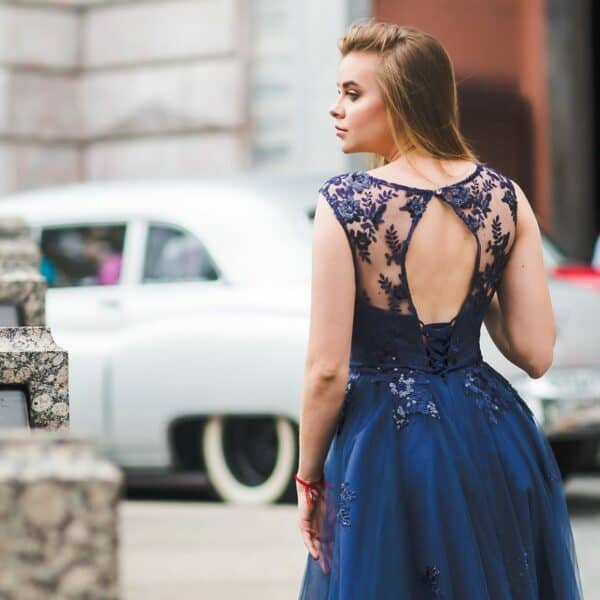Deciding whether to have a bustle on your wedding dress or change into a second dress for your reception will be something a lot of brides have to consider. The bustle protects the train of your gown from getting damaged or dirty at your wedding reception.
We look at 5 wedding dress bustles you will love if you decide to go down this route with your wedding dress. Of course the alteration will have to be done prior to the wedding, so you will need to decide in advance about your bustle.
What Exactly Is A Bustle?
Once upon a time bustles were padded undergarments that were added underneath a lady’s dress to support the drapery at the back of her dress. This gave her the appearance of having an elongated train.
The fashion then evolved into a more definitive hump with the fabric of the dress falling sharply to the floor.
Today a bustle is not a separate undergarment or item of clothing. Instead it is a technique for taking the fabric of a wedding dress train and attaching it to the dress in various ways.
We are taking a look at five different ways a bustle can be fashioned on a wedding dress.
Over Bustle
An over bustle is also called a traditional or American style bustle. How the overbustle looks depends on the length of the train, the style of the dress, how many attachment points there are and how high up the dress it is attached.
Creating An Over Bustle
To create an overbustle, buttons or hooks and loops are used. The buttons or hooks are attached on the outside of the dress fabric at the height that the bustle will be attached.
The loops are added lower down the dress at various points around the train of the wedding gown. This lifts the train off of the floor so that it is not being dragged on the floor during the wedding reception and at risk of being stepped on or ripped.
Occasionally the overbustle allows some of the train to sweep on the floor for effect. When hooks are used to lift the train fabric off the floor they are usually hidden in the lace, detailing or pleats in the back of the wedding dress.
When buttons are used they may be covered to match the dress fabric. It is possible to create the overbustle with just one attachment point or several.
As modern dresses tend to have shorter court or sweep trains rather than the cathedral or church trains of years ago four to six points will normally be used for the overbustle.
Under Bustle
The under bustle is also known as the European bustle or the French bustle. However, under bustle is more descriptive as the fabric from the train is tucked up under the skirt of the wedding dress.
When the under bustle is created it sticks out less than the overbustle as when it is done it forms a flap on the back of the dress.
Creating An Under Bustle
Unlike the over bustle which is created with buttons or hooks and loops the under bustle is typically done with ribbon ties. These operate in pairs and may be either color coordinated or numbered, so it is clear which two tie together.
When the bustle needs to be tied up at the wedding reception the train of the dress needs to be lifted up so that whoever is helping to tie up the bustle can get to the ribbon ties. This will need to be done in private, so that the bride retains her modesty.
Each pair of ribbons are tied together underneath the fabric and this has the effect of lifting the bottom of the dress off of the floor.
The look and detail of the wedding dress should be maintained as much as possible when the under bustle is created.
Invisible Bustle
The invisible bustle gives a very minimalist and clean look to the dress. In fact, it doesn’t look like it has been bustled and that the dress was always just a floor length gown.
Of all the bustles this may be the most expensive to have done by your seamstress, but your wedding dress will look completely different from the ceremony to the reception.
It’s almost like having two dresses in one. And it is cheaper than buying a separate dress for the reception.
Creating An Invisible Bustle
If you really don’t like the look of bustles then having one that is invisible is the answer if you want to protect your wedding dress train.
In this type of bustle the train of the dress is brought up inside the dress and fastened in place. This gives the illusion of there being no train at all and makes the gown seem as if it was made as floor length.
There are no folds, flaps or pleats on the outside of the dress.
This bustle works particularly well on A-line and ballgown type wedding dresses. It also works brilliantly with sheath silhouettes and helps to maintain the dress’s clean, simple and elegant lines.
An invisible bustle retains the silhouette of these types of gowns, so nothing about the shape is lost, and your train is protected for your wedding reception.
You also have the appearance of two different wedding gowns, one for the ceremony with its long flowing train, and another for the reception with a floor length hem allowing you to dance the night away.
As the invisible bustle hides the entire train there will be a lot of attachment points, but your seamstress will make sure they too are invisible.
Austrian Bustle
Quite the opposite of the invisible bustle is the less common Austrian bustle. This type of bustle proudly displays the excess fabric of your train on the back of your wedding dress as a series of elaborate ruffles or ruches.
Difficult to construct but simple to use, the Austrian bustle looks elegant and does an excellent job of keeping your train up and allowing you to be hands free for the reception.
Creating An Austrian Bustle
This bustle won’t work on every wedding dress and can depend on the fabric involved. You also don’t want to cover up any of the beauty of your gown which an over bustle or under bustle tends to do.
For a beautiful lace wedding dress an Austrian bustle protects the train by lifting it off the floor, but the lace detail is still visible. Not only that but it is fashioned into one of the prettiest bustles possible.
An Austrian bustle is created by installing a drawstring system under the skirt of the dress which pulls the train up off the floor and into soft ruches on the back of the wedding gown. It can be placed on the center seam or in several places on the train.
The ornate, draping effect is really pretty especially on lace or silk crepe dresses. As it involves a lot of work it is one of the more expensive options, but the result will be worth it. Your train will be protected, and your bustle will look stunning.
Wristlet Bustle
The wristlet bustle is reminiscent of bygone eras when ladies had to hold their trains off the floor for dancing. This type of bustle is the simplest and most affordable option for protecting your train and allowing freedom of movement at your reception.
Creating A Wristlet Bustle
To create a wristlet bustle a loop goes around the bride’s wrist and the tip of the wedding train is attached to it.
This lifts the train clear of the floor allowing ease of movement around the reception to greet guests and for dancing it protects the train from being damaged.
This type of bustle is best used for medium to long trains which will reach your wrist without hiking the hem of the dress up too far. It is also best suited for lighter fabrics as over the course of the day and evening it can start to weigh heavily on your wrist.
How Do You Know Which Bustle Is Right For Your Wedding Gown?

Choosing the right bustle for your wedding gown is a process that should happen in collaboration with your seamstress.
Most dresses do not come with built-in bustles, so this is something that will have to be added to the wedding gown by a professional dressmaker.
The type of bustle will depend on your height, the silhouette of your gown, the fabric and your personal preferences.
Your seamstress will be able to advise you on the best choice of bustle for your dress as she will have had lots of experience with what works and what doesn’t.
Costs To Consider
As the bustle is an addition or alteration to your wedding gown you will need to have a seamstress do this for you.
Something as simple as the wristlet bustle could be done by someone who is comfortable with a sewing machine, but it is best to get professional help.
This of course will cost you extra so make sure you budget for the service. The cost will depend on the complexity of the bustle you have and how much work is involved.
In Conclusion
Bustles are a great way of having your train safely off the floor for your wedding reception allowing you to mingle with guests and dance in comfort.
We hope that this guide to 5 wedding dress bustles has helped you and given you some inspiration for your wedding gown.
- Full Breakdown: How Much Does Your Dream Disney Wedding Really Cost? - April 13, 2023
- Magical Beginnings: 11 Steps for Planning Your Dream Disney Wedding - April 8, 2023
- 40 Unique Gifts For Daughter On Her Wedding Day - March 25, 2023




Leave a Comment